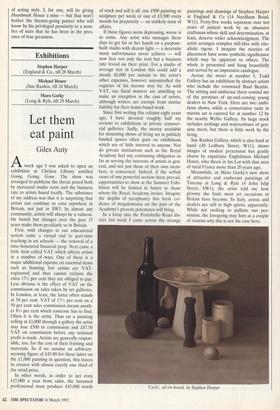Exhibitions
Stephen Harper (England & Co., till 28 March) Michael Hoare (Sue Rankin, till 24 March) Maro Gorky (Long & Ryle, till 29 March)
Let them eat paint
Giles Auty
Aweek ago I was asked to open an exhibition at Chelsea Library entitled Going, Going, Gone. The show was arranged to publicise the threat posed both by increased studio rents and the business rate to artists based locally. The substance of my address was that it is surprising that artists can continue to exist anywhere in Britain, not just in SW3. In almost any community, artists will always be a vulnera- ble bunch but changes over the past 15 years make them peculiarly so in Britain.
First, with changes in our educational system came a virtual end to part-time teaching in art schools — the removal of a time-honoured financial prop. Next came a little item called VAT which affects artists in a number of ways. One of these is a major additional expense on essential items such as framing: few artists are VAT- registered and thus cannot reclaim the extra 171/2 per cent they are obliged to pay. Less obvious is the effect of VAT on the commission on sales taken by art galleries. In London, at least, the latter often stands at 50 per cent. VAT of 171/2 per cent on a 50 per cent sales commission means anoth- er 81/4 per cent which someone has to find. Often it is the artist. Thus on a painting selling at £1,000 through a gallery the artist may lose £500 in commission and £87.50 VAT on commission before any notional profit is made. Artists are generally respon- sible, too, for the cost of their framing and materials. So if we assume an arbitrary- seeming figure of £45.80 for these latter on the £1,000 painting in question, this leaves its creator with almost exactly one third of the retail price.
In other words, in order to net even £15,000 a year from sales, the harassed professional must produce £45,000 worth
of stock and sell it all: one £900 painting or sculpture per week or one of £3,500 every month for perpetuity — an unlikely state of affairs.
If these figures seem depressing, worse is to come. Any artist who manages these days to get his or her hands on a purpose- built studio with decent light — a necessity many unfortunates never achieve — will now face not only the rent but a business rate levied on their prize. For a studio of average size in London this could add a steady £6,000 per annum to the artist's other expenses, however uncontrolled the vagaries of his income may be. As with VAT, our fiscal masters are unwilling to make an exception in the case of artists, although writers are exempt from similar liability for their home-based work.
Since first writing this column eight years ago, I have devoted roughly half my reviews to exhibitions in private commer- cial galleries. Sadly, the money available for mounting shows of living art in publicly funded spaces often goes on exhibitions which are of little interest to anyone. Nor do private institutions such as the Royal Academy feel any continuing obligation so far as serving the interests of artists in gen- eral, and not just those of their own mem- bers, is concerned. Indeed, if the selfish views of one powerful section there prevail, opportunities to show at the Summer Exhi- bition will be limited in future to those whom the Royal Academy invites. Imagine the depths of sycophancy this fresh evi- dence of megalomania on the part of the Academy's present potentates will bring.
In a foray into the Portobello Road dis- trict last week I came across the, strange paintings and drawings of Stephen Harper at England & Co (14 Needham Road, W11). Forty-five works represent over ten years of patient work by an obsessive craftsman whose skill and determination, at least, deserve wider acknowledgment. The artist arranges complex still-lifes with ritu- alistic rigour. I imagine the niceties of placement have some symbolic significance which may be apparent to others. The whole is presented and hung beautifully and served by an impressive catalogue.
Across the street at number 5, Todd Gallery has an exhibition by abstract artists who include the renowned Basil Beattie. The setting and ambience there remind me of the premises of up-and-coming young dealers in New York. Here are two ambi- tious shows, while a conservative taste in marine art is catered for at number 12 by the nearby Wyllie Gallery. Its large stock includes etchings and watercolours of gen- uine merit, but there is little work by the living.
Sue Rankin Gallery, which is also hard at hand (40 Ledbury Street, W11), shows images of modest pretension but gentle charm by expatriate Englishman Michael Hoare, who threw in his Lot with that area of rural France more than 20 years ago.
Meanwhile, at Maro Gorky's new show of attractive and exuberant paintings of Tuscany at Long & Ryle (4 John Islip Street, SW1), the artist told me how gloomy she finds most art occasions in Britain have become. In Italy, artists and dealers are still in high spirits, apparently. While not seeking to palliate our pes- simism, the foregoing may hint at a couple of reasons why this is not the case here.
`Cycle, oil on board, by Stephen Harper


























































 Previous page
Previous page